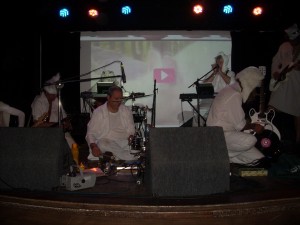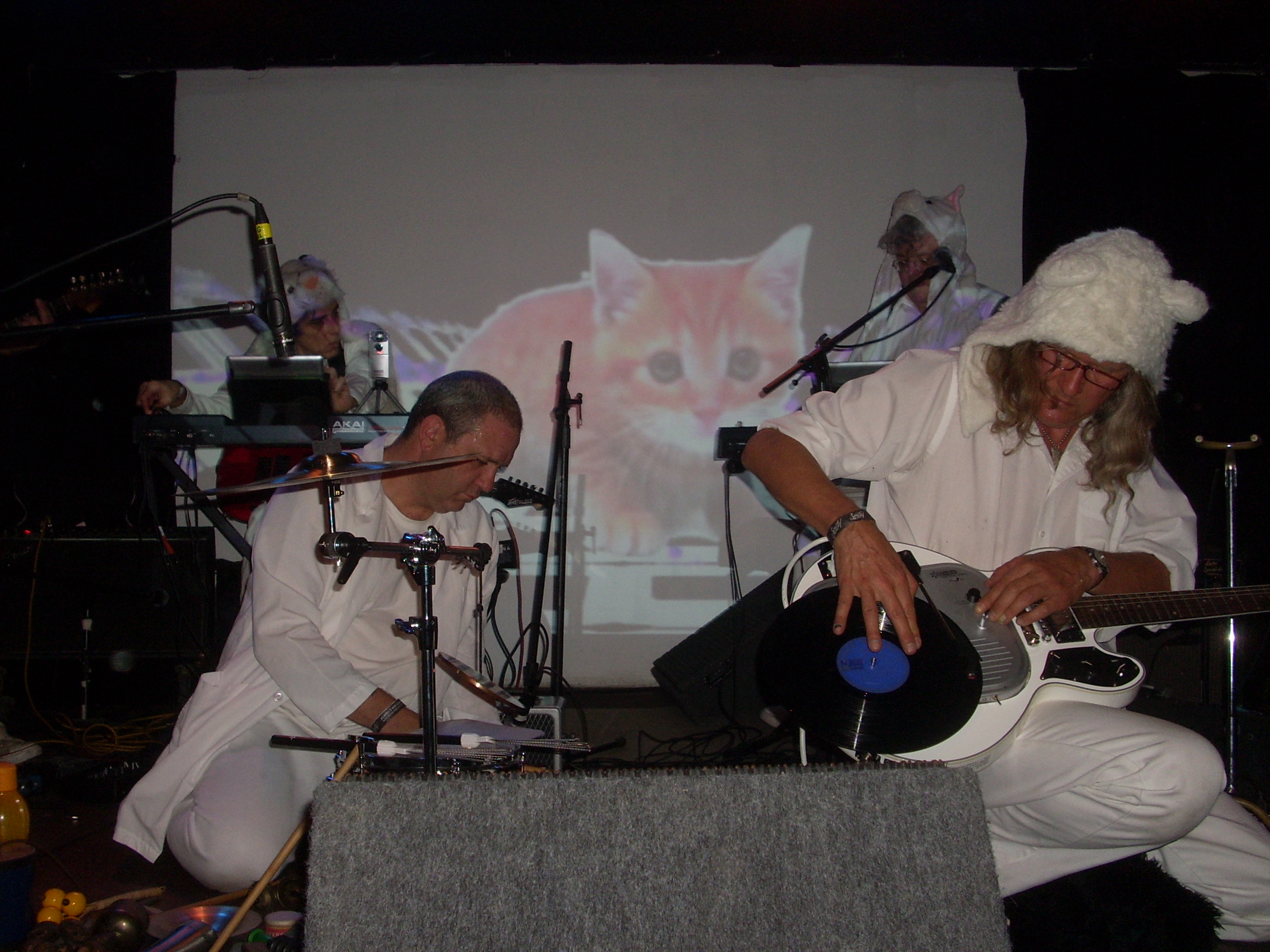 Could there be such a thing as an orchestra of memory? A kind of color-organ (remember those?—no, of course you don’t; you’re too young) soundtrack of apprehension, clairvoyance, and the insight and deep vision of compressed years? (And how, after all, do we compress all that information digitally into MP3s, CDs, digital downloads. etc.?) The members of Cat Museum have apparently asked similar (but different) questions—all at different times; and frequently in different rhythms and time and key signatures—converging serendipitously on certain memorable (or variously notorious or simply ridiculous) riffs, tunes, harmonies, musical or simply aural associations, including the sonic and digital detritus of everyday urban life, going back (as far as I can tell) 60 or 70 years, or conceivably beyond that. In that they resemble, ever so slightly, The Real Tuesday Weld; but unlike TRTW, instead of collaging pop snippets into retro-novelty tune curiosities with bouncy techno rhythm tracks (not that I have anything against that—I like some TRTW tunes), for Cat Museum, these ‘bits’ are just one element in rich, dense, continuously morphing (and warping) tapestries of sound that bleed into a sonic domain that can stretch precariously into something approaching white noise—or perhaps a black hole.
Could there be such a thing as an orchestra of memory? A kind of color-organ (remember those?—no, of course you don’t; you’re too young) soundtrack of apprehension, clairvoyance, and the insight and deep vision of compressed years? (And how, after all, do we compress all that information digitally into MP3s, CDs, digital downloads. etc.?) The members of Cat Museum have apparently asked similar (but different) questions—all at different times; and frequently in different rhythms and time and key signatures—converging serendipitously on certain memorable (or variously notorious or simply ridiculous) riffs, tunes, harmonies, musical or simply aural associations, including the sonic and digital detritus of everyday urban life, going back (as far as I can tell) 60 or 70 years, or conceivably beyond that. In that they resemble, ever so slightly, The Real Tuesday Weld; but unlike TRTW, instead of collaging pop snippets into retro-novelty tune curiosities with bouncy techno rhythm tracks (not that I have anything against that—I like some TRTW tunes), for Cat Museum, these ‘bits’ are just one element in rich, dense, continuously morphing (and warping) tapestries of sound that bleed into a sonic domain that can stretch precariously into something approaching white noise—or perhaps a black hole.
Imagine taking a walk down a city street. That begins somewhere in America. Maybe somewhere in the industrial Rust Belt. Or the Kennedy Space Center or some secret test site (sure, why not? You don’t think the CIA or FBI or NSA hasn’t already tried it?). Heavy construction; street musicians; vendors hawking this and that. And then it somehow morphs into a foreign capital, say in Pakistan. Except on another planet. And it’s all in a movie – a bit Bollywood – with commercial interruptions. Or maybe it’s all in your head. I mean, the dentist or the eye doctor just gave you some heavy anaesthetic and a drill is rapidly approaching your eye – tooth – or is it your ear? The scene’s dissolving into another scene – and so are you – and you thought you had just subscribed to a cycle of the Mozart Haydn quartets – but the dissonances belong to Lou Reed’s Metal Machine Music. Well you did; and it does. Welcome to the Cat Museum.
Cat Museum should in no way be mistaken for an ‘art rock’ band, although in some respects, they satisfy the same criteria (especially where the plastic arts are concerned—more on this in a minute). No. This is where an actual avant-garde meets the club scene. (But isn’t it about time?) Judging from the response (enthusiastic to orgiastic) to their show Friday night at El Cid on Sunset in Silver Lake, I think they’re beginning to find their audience. Like good dejays, they seem to know how to herd us around (we’re cats, right?); make that multiple deejays on multiple turntables (uh, maybe literally). From an opening keyboard figure or chord, guitar lick, or rhythm track, they move us through multiple moods, decades, environments, morphing rhythm into rhythm, elaborating a fragment of a tune across several instruments, modulating harmonies into complex pools of sound. We go from 1950s horror/sci-fi soundtrack to a blues harp riff, to a violin solo to violent sonic winds whipping through a desert canyon. As neon cats vibrate on the screen, a message bounces alongside, “An error occurred, Please try again.” The rhythms start to syncopate and suddenly we’re in the middle of a heavy metal jam with searing upper register chords.
 In an earlier iteration of this post, I identified Bill Kates as the ‘chief curator’ behind the Museum, commanding keyboards, synthesizer, MacBook, and various electronics – and essentially what sound like digital/audio versions of the Television, Motion Picture Academy, and Jurassic Museums packed up in them. In actuality, it’s Victor Charles Balogh who’s the master-magician/music director, also commanding the “magic boxes” (Bill’s term) and guitars. Their fellow musicians – Jim Within (keyboards, guitar, vocals), Eric Potter (“guitars, guitars, guitars”), Matt Fielder (guitars, “DaDa theatrics, and Dance”), Izzy Alive (Moog synthesizer and “technical support”), and Pete Plumley (“Special Effects,” etc.) – are fantastically in synch with whatever melodies, harmonies, rhythms, musical motives, clips, samples, or raw sounds he throws at them, and resourceful enough to take them in just about any direction – into the darkest sonic holes or straight to the stars.
In an earlier iteration of this post, I identified Bill Kates as the ‘chief curator’ behind the Museum, commanding keyboards, synthesizer, MacBook, and various electronics – and essentially what sound like digital/audio versions of the Television, Motion Picture Academy, and Jurassic Museums packed up in them. In actuality, it’s Victor Charles Balogh who’s the master-magician/music director, also commanding the “magic boxes” (Bill’s term) and guitars. Their fellow musicians – Jim Within (keyboards, guitar, vocals), Eric Potter (“guitars, guitars, guitars”), Matt Fielder (guitars, “DaDa theatrics, and Dance”), Izzy Alive (Moog synthesizer and “technical support”), and Pete Plumley (“Special Effects,” etc.) – are fantastically in synch with whatever melodies, harmonies, rhythms, musical motives, clips, samples, or raw sounds he throws at them, and resourceful enough to take them in just about any direction – into the darkest sonic holes or straight to the stars.
When I first saw the Museum, they were playing behind the artist (and sometime writer), Anthony Ausgang (himself known for the cats and feline creatures that populate some of his best known paintings), reading from his book, The Sleep of Puss Titter. Anthony is now fully involved with the band; and in addition to the light and digital animation show (plenty of cats featured in every conceivable digital distortion and contortion imaginable) he produced for the screen backdrop, played what looked like a bass guitar with a pick-up that looked like a vinyl record disc – which on closer inspection turned out to be an actual working turntable fully mounted and inset into a guitar. Periodically, he would pick up a record from a stack and work the turntable (which sort of felt like a Jurassic iteration of Bill’s and Victor’s electronic bags of magic tricks). They were just getting started. The genius percussionist next to him, Andy Sykora, appeared to be making a Jenga stack of objects on one of his cymbals. As if sight and sound weren’t smoking enough, he lit something on fire at one point. (No one got burned.) Somehow it all worked. We all went home purring.


